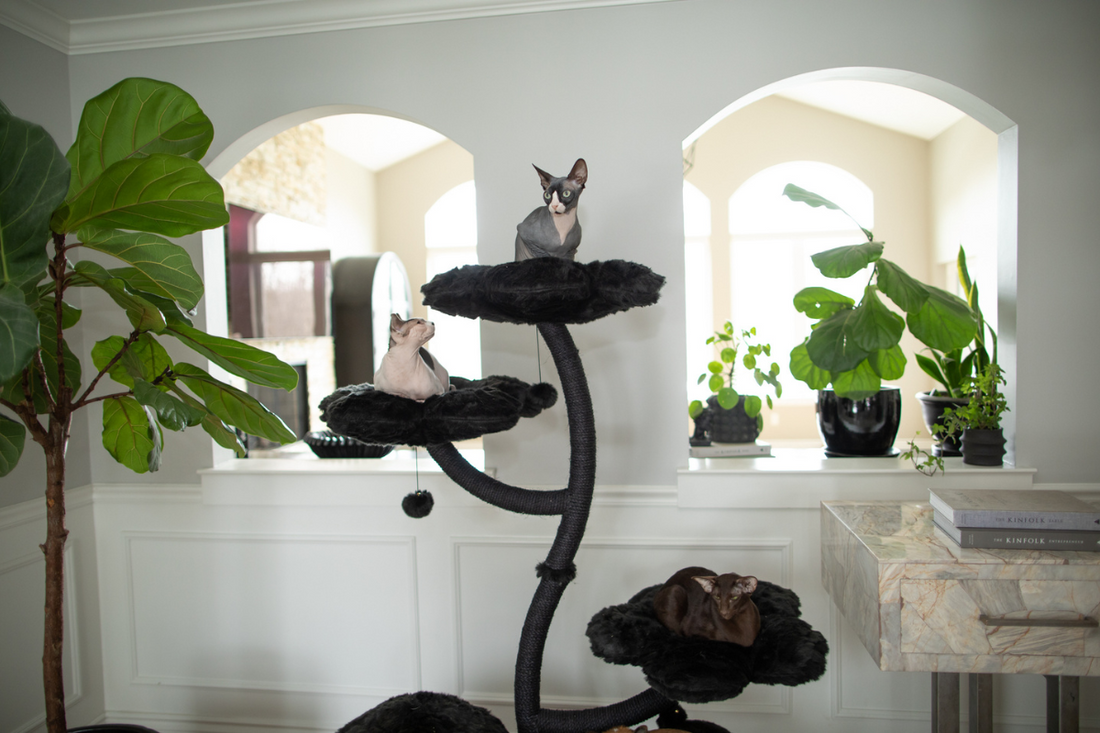Cats might be cuddly companions on the couch, but beneath those soft purrs is a creature built for climbing, stalking, and surveying its environment. Understanding feline behavior is key to creating a home that supports both their instincts and wellbeing. Cats are natural climbers and territorial animals. Unlike dogs, they don’t just roam on ground level — they think vertically.
In the wild, a cat’s environment is full of trees, rocks, and high ledges. These vertical structures serve as lookout points, safe spaces from predators, and areas to hunt from. When cats live indoors, these same needs persist — but they don’t always have the means to satisfy them. This is where the question of why cats need cat trees becomes not just relevant, but essential. Cat trees do more than just look nice in the corner; they serve a behavioral and emotional function that can make a world of difference in your cat’s life.
Understanding the Need for Vertical Space
Why do cats need vertical space? It’s not just a preference — it’s a deeply rooted survival mechanism. In multi-cat households or homes with children and dogs, cats often seek out high places as a way to create boundaries and feel safe. Vertical territory allows them to observe their surroundings without feeling threatened, which can reduce territorial conflicts and anxiety.
Vertical space also allows cats to claim areas without taking over floors or furniture. This is particularly useful in smaller living spaces, where every square foot matters. When you give your cat a space of their own up high, it provides them with ownership and confidence.
Cat climbing furniture like trees, perches, and wall-mounted shelves allow indoor cats to mimic the experience of exploring a forest canopy. In behavioral terms, this is enriching and essential. Providing these spaces gives your cat options — to climb, retreat, or perch peacefully — all of which contribute to a balanced, less stressed feline.
So if you’ve been wondering, “why cats need cat trees,” consider this: they’re a vertical escape that supports natural behaviors, reduces tension in multi-cat homes, and keeps your furniture scratch-free.
The Role of Cat Trees in Natural Instincts
Cats are hunters at heart. Even the most pampered housecat still carries the instincts of their wild ancestors. Climbing, hiding, perching, and scratching aren’t just “quirks” — they’re behaviors essential to a cat’s mental health. Cat trees support these instincts in an indoor setting.
A well-designed cat tree gives your cat a chance to stalk from above, pounce from ledges, and scratch in a satisfying way — all without getting in trouble. Scratching posts built into cat trees also serve as territory markers through scent and claw marks, helping reduce furniture damage and reinforcing their sense of space.
For cats who don’t go outside, the lack of natural stimulus can lead to boredom, anxiety, and even behavioral issues like overgrooming or aggression. A cat tree can act as a “mini wilderness,” offering climbing challenges, hiding spots, and lookout platforms. In short, it helps maintain your cat’s natural behavior patterns in a safe, indoor environment.
Understanding cat behavior and habitats means recognizing that cats need more than toys and treats. They need a place to act like a cat. That’s where cat trees come in — they’re not a luxury; they’re a behavioral necessity.
Health Benefits of Using Cat Trees
Beyond behavior, cat trees offer a range of physical and emotional health benefits. Indoor cats are prone to weight gain and under-stimulation, both of which can lead to health problems like obesity, arthritis, and anxiety. The benefits of cat trees go far beyond aesthetics — they actively support a cat’s overall health.
1. Joint Health & Agility
Climbing helps maintain joint flexibility and muscle strength. For older cats, choosing a tree with ramps or lower platforms can encourage gentle movement and prevent stiffness.
2. Weight Management
Movement between levels encourages physical activity without feeling like “exercise.” Climbing, jumping, and stretching out on various platforms burns calories and keeps your cat in better shape — crucial for indoor cats with limited space.
3. Stress Reduction
Having a secure perch allows cats to relax and feel in control. This is particularly important in busy households where stimulation is high. Elevated platforms give your cat a place to decompress and feel safe, especially in households with kids or multiple pets.
4. Scratching Relief
Scratching is a physical and emotional release for cats. Trees with sisal-covered posts satisfy that urge while saving your carpets and couches.
The cat tree's health benefits make them more than just “nice to have.” They’re part of a proactive plan to support your cat’s body and mind — a simple step with long-term payoffs in wellness and happiness.
Physical Exercise
Indoor cats don’t always get the movement they need, which can quickly lead to weight issues or lethargy. Cat trees encourage movement naturally. Each jump, climb, and stretch contributes to better circulation, joint health, and overall agility.
Cats don’t go for jogs like dogs, but they’re excellent at short bursts of activity. Having a vertical structure to navigate gives them that opportunity without needing a huge space. Think of it as a feline home gym — one that supports their natural movement patterns in a way that feels fun, not forced.
Regular use of cat climbing furniture can be a game-changer for keeping your indoor cat active and healthy. It's one of the easiest ways to support your pet’s fitness without ever leaving the house.
Mental Stimulation
Cats need more than food and water to stay happy — they need mental stimulation, too. A bored cat can become destructive, anxious, or even depressed. Cat trees are a powerful tool for keeping their minds engaged.
Exploring new levels, hiding in cubbies, watching birds from a window perch — these activities tap into your cat’s natural curiosity. Some trees even include dangling toys or puzzle compartments to add a little challenge.
When considering indoor cat enrichment, cat trees should be at the top of the list. They provide dynamic spaces that change depending on the cat’s mood and activity level. Whether it’s an intense play session or an afternoon nap, a cat tree supports every part of your cat’s mental well-being — keeping boredom at bay and behavior issues to a minimum.
Creating a Safe Environment for Cats
Cats thrive in environments that make them feel safe and in control. In a multi-pet household, or even one with unpredictable noise and traffic, a cat needs a place to retreat. Cat trees offer that sanctuary.
Perched high above the chaos, a cat can observe from a safe distance. This reduces stress and helps manage issues like hiding under furniture or aggressive outbursts. For shy or rescue cats, having a designated space that’s just for them can help them come out of their shell more quickly.
Look for trees that offer enclosed cubbies or hammocks in addition to perches. These provide a range of “safe zones” depending on your cat’s comfort level.
The impact of cat trees on behavior is most noticeable when your cat starts using it as their go-to rest and recovery spot. You may even find they stop hiding behind appliances or under beds — they finally have a place that feels secure and their own.
In terms of indoor cat enrichment, the cat tree is more than furniture. It’s a confidence booster, a security blanket, and a behavior stabilizer — all in one.
Choosing the Right Cat Tree for Your Pet
Not all cat trees are created equal, and picking the right one can make all the difference. Start by considering your cat’s age, size, and personality. Is your cat a senior who needs gentle ramps and lower platforms? Or are you housing a young climber who craves vertical challenges?
Stability should be a top priority. A wobbly cat tree is a no-go — especially for large breeds like Maine Coons or active cats who love to leap. Look for sturdy bases, strong materials, and secure attachments.
Texture matters too. Cats love sisal for scratching and soft carpet for lounging. Platforms should be large enough for your cat to fully stretch out. And for multi-cat households, multiple levels and cubbies are a must to prevent territorial disputes.
Finally, place your cat tree where it matters — near a window for birdwatching, or in a quiet corner for uninterrupted naps.
When it comes to choosing the best cat trees, think about how your cat uses space. The better the match, the more use your feline friend will get out of it — and the happier and healthier they’ll be as a result.
The Importance of Cat Trees in a Happy Home
Cat trees aren’t just fancy furniture — they’re a behavioral, physical, and emotional lifeline for indoor cats. They provide vertical territory, encourage exercise, support instinctual behaviors, and give your cat a safe space to unwind. If you care about your cat’s wellbeing, investing in a quality cat tree is one of the best things you can do.
At kbspets.com, we offer a wide selection of thoughtfully designed cat trees that support both your cat’s needs and your home’s aesthetics. Give your feline the environment they deserve — because a happy cat makes a happy home.
FAQs
Q: Why do cats prefer high places?
A: High places give cats a sense of safety, control, and territory. It’s instinctual — in the wild, elevated spaces offer protection and better visibility.
Q: What are the benefits of having a cat tree?
A: Cat trees support exercise, stress relief, scratching, mental stimulation, and give your cat a place to feel secure.
Q: How can cat trees reduce anxiety in cats?
A: Elevated perches and enclosed cubbies provide safe retreats. This helps cats feel more in control and reduces stress-related behaviors.
Q: What features should I look for in a cat tree?
A: Look for stability, varied heights, scratching posts, cozy lounging spots, and safe materials suited to your cat’s size and age.
Q: How often should I replace my cat tree?
A: Typically every 2-4 years, or sooner if parts are damaged or unstable. Regular inspection ensures safety and comfort.
Need help picking the right cat tree? Browse our selection at kbspets.com — where quality meets comfort for every cat.


